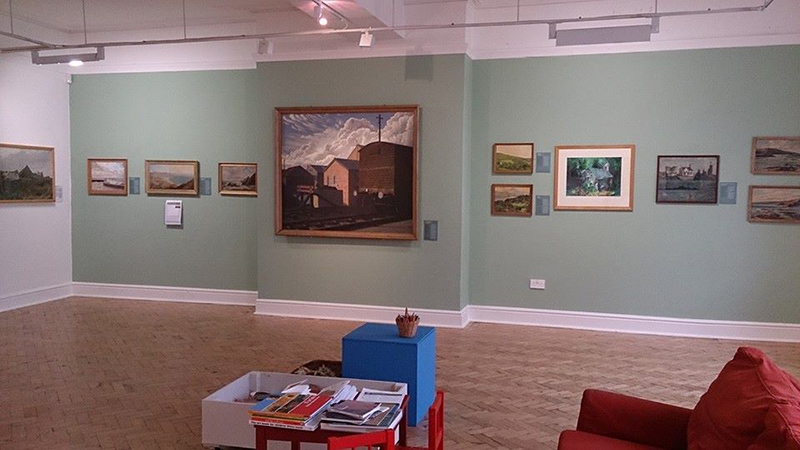Ceredigion Museum, Aberystwyth
After the success of Into the West, both popular and critical, the Ceredigion Museum has reached into its own holdings for its summer exhibition. Under Alice Briggs’ curatorship As Far as the Eye Can See comprises twenty-seven hung pictures and seven drawings in a cabinet. The result is a small space comprising a diversity of styles and periods hung in stimulating apposition. The pleasure to be had is enhanced by the gallery’s lay-out, not just a sofa and art books but the presence of a sandpit.
Two large canvases of equal size, five-foot square, are hung opposite each other. Olivier Debré’s ‘Gwaith Goginan’ of 1976 is an exercise in abstract greens. Steve Whtehead’s ‘The Coal Yard’ by contrast is a realist work in which a cramped sky of massed cumulus overlooks an ensemble of sharp-angled building, buffer and railway wagon. The inclusion of a coal bunker is reminder of a time when stations doubled up as fuel depots for dozens of local coal merchants. Another piece of Ceredigion history features in Aneurin Jones’ scene of a snow-bound River Mwldan in Cardigan. The bucolic scene is now long-gone, a new and deserted highway in its place, leading to a supermarket that has yet to arrive.
Buildings may come and go but the lineaments of nature hardly alter. A E Morleboys painted ‘Craiglas Rocks’ in 1896- the caption comment is ‘playful’. Morleboys includes a pair of small figures at play on the edge of the sea but the view north is little different from that of today. The same is true of Edmund Mariner Gill’s view of Aberystwyth, the perspective from near the summit of Constitution Hill. The town itself has swelled but the receding line of cliffs that ends with Newquay is instantly identifiable.
The curatorial comment is crisp and to the point. There ‘is no singular sense of place in Ceredigion but there is a coherently shared appreciation for the county which has developed into diverse forms of artistic expression.’ The gallery windows look west to the sea and the wall is hung with two examples of modernity. ‘Tirlun Gwyrdd Las’ by Mary Lloyd Jones is a turbulent scene that hovers on abstraction’s borderline. Karen Pearce’s ‘Aberystwyth from Constitution Hill’ has its roots in naturalistic observation and is given a heightened treatment of light and contrast for emotional effect.
The same contrast of dark and light floods John Piper’s view of a small chapel within a setting of unconstrained nature. It encapsulates Piper’s dual approach, the reverer of eighteenth classicism alongside the neo-romantic heir of Palmer. Nearby is hung a view from the sea of Aberystwyth’s castle and headland. The lines of the buildings are thickly marked and the naïve picture sums up the pleasure of As Far as the Eye Can See. The eye can turn one way and see an artist without formal training. Turn the eye in another direction and it sees a master at work, applying his paint with the palette knife. The dark tones, the weight of rock and the gauntness of the sky in ‘Farm Behind Harlech’ are pure Kyffin Williams.
As Far as the Eye Can See continues until 29 September.












